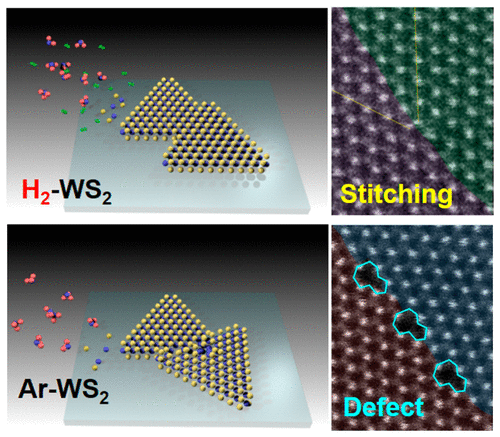当前位置:
X-MOL 学术
›
Chem. Mater.
›
论文详情
Our official English website, www.x-mol.net, welcomes your feedback! (Note: you will need to create a separate account there.)
Hydrogen-Assisted Epitaxial Growth of Monolayer Tungsten Disulfide and Seamless Grain Stitching
Chemistry of Materials ( IF 8.6 ) Pub Date : 2018-01-03 00:00:00 , DOI: 10.1021/acs.chemmater.7b04149 Hyun Goo Ji 1 , Yung-Chang Lin 2 , Kosuke Nagashio 3 , Mina Maruyama 4 , Pablo Solís-Fernández 5 , Adha Sukma Aji 1 , Vishal Panchal 6 , Susumu Okada 4 , Kazu Suenaga 2 , Hiroki Ago 1, 5
Chemistry of Materials ( IF 8.6 ) Pub Date : 2018-01-03 00:00:00 , DOI: 10.1021/acs.chemmater.7b04149 Hyun Goo Ji 1 , Yung-Chang Lin 2 , Kosuke Nagashio 3 , Mina Maruyama 4 , Pablo Solís-Fernández 5 , Adha Sukma Aji 1 , Vishal Panchal 6 , Susumu Okada 4 , Kazu Suenaga 2 , Hiroki Ago 1, 5
Affiliation

|
Recently, research on transition metal dichalcogenides (TMDCs) has been accelerated by the development of large-scale synthesis based on chemical vapor deposition (CVD). However, in most cases, CVD-grown TMDC sheets are composed of randomly oriented grains, and thus contain many distorted grain boundaries (GBs) which deteriorate the physical properties of the TMDC. Here, we demonstrate the epitaxial growth of monolayer tungsten disulfide (WS2) on sapphire by introducing a high concentration of hydrogen during the CVD process. As opposed to the randomly oriented grains obtained in conventional growth, the presence of H2 resulted in the formation of triangular WS2 grains with the well-defined orientation determined by the underlying sapphire substrate. Photoluminescence of the aligned WS2 grains was significantly suppressed compared to that of the randomly oriented grains, indicating a hydrogen-induced strong coupling between WS2 and the sapphire surface that has been confirmed by density functional theory calculations. Scanning transmission electron microscope observations revealed that the epitaxially grown WS2 has less structural defects and impurities. Furthermore, sparsely distributed unique dislocations were observed between merging aligned grains, indicating an effective stitching of the merged grains. This contrasts with the GBs that are observed between randomly oriented grains, which include a series of 8-, 7-, and alternating 7/5-membered rings along the GB. The GB structures were also found to have a strong impact on the chemical stability and carrier transport of merged WS2 grains. Our work offers a novel method to grow high-quality TMDC sheets with much less structural defects, contributing to the future development of TMDC-based electronic and photonic applications.
中文翻译:

氢辅助外延生长单层二硫化钨和无缝晶粒拼接
近来,通过基于化学气相沉积(CVD)的大规模合成技术的发展,已经加速了过渡金属二硫化碳(TMDC)的研究。但是,在大多数情况下,CVD生长的TMDC薄板由随机取向的晶粒组成,因此包含许多扭曲的晶界(GB),这会恶化TMDC的物理性能。在这里,我们通过在CVD工艺中引入高浓度的氢来证明蓝宝石上单层二硫化钨(WS 2)的外延生长。与常规生长中获得的随机取向晶粒相反,H 2的存在导致形成三角形WS 2具有明确定义的取向的晶粒,由下层的蓝宝石衬底决定。与随机取向的晶粒相比,对齐的WS 2晶粒的光致发光得到了显着抑制,表明氢诱导的WS 2与蓝宝石表面之间的强耦合已经通过密度泛函理论计算得到了证实。扫描透射电镜观察发现,外延生长的WS 2具有较少的结构缺陷和杂质。此外,在合并排列的晶粒之间观察到稀疏分布的唯一位错,表明合并晶粒的有效缝合。这与在随机取向的晶粒之间观察到的GB形成对照,这些晶粒沿GB包括一系列8、7和交替的7/5元环。还发现GB结构对合并的WS 2晶粒的化学稳定性和载流子传输具有强烈影响。我们的工作提供了一种新颖的方法,可以生产出结构缺陷少得多的高质量TMDC薄板,为基于TMDC的电子和光子应用的未来发展做出了贡献。
更新日期:2018-01-03
中文翻译:

氢辅助外延生长单层二硫化钨和无缝晶粒拼接
近来,通过基于化学气相沉积(CVD)的大规模合成技术的发展,已经加速了过渡金属二硫化碳(TMDC)的研究。但是,在大多数情况下,CVD生长的TMDC薄板由随机取向的晶粒组成,因此包含许多扭曲的晶界(GB),这会恶化TMDC的物理性能。在这里,我们通过在CVD工艺中引入高浓度的氢来证明蓝宝石上单层二硫化钨(WS 2)的外延生长。与常规生长中获得的随机取向晶粒相反,H 2的存在导致形成三角形WS 2具有明确定义的取向的晶粒,由下层的蓝宝石衬底决定。与随机取向的晶粒相比,对齐的WS 2晶粒的光致发光得到了显着抑制,表明氢诱导的WS 2与蓝宝石表面之间的强耦合已经通过密度泛函理论计算得到了证实。扫描透射电镜观察发现,外延生长的WS 2具有较少的结构缺陷和杂质。此外,在合并排列的晶粒之间观察到稀疏分布的唯一位错,表明合并晶粒的有效缝合。这与在随机取向的晶粒之间观察到的GB形成对照,这些晶粒沿GB包括一系列8、7和交替的7/5元环。还发现GB结构对合并的WS 2晶粒的化学稳定性和载流子传输具有强烈影响。我们的工作提供了一种新颖的方法,可以生产出结构缺陷少得多的高质量TMDC薄板,为基于TMDC的电子和光子应用的未来发展做出了贡献。


























 京公网安备 11010802027423号
京公网安备 11010802027423号